 |
PO
Box 9021, Wilmington, DE 19809, USA
E-mail: font@focusonnature.com
Phone: Toll-free in USA 1-888-721-3555
or 302/529-1876 |
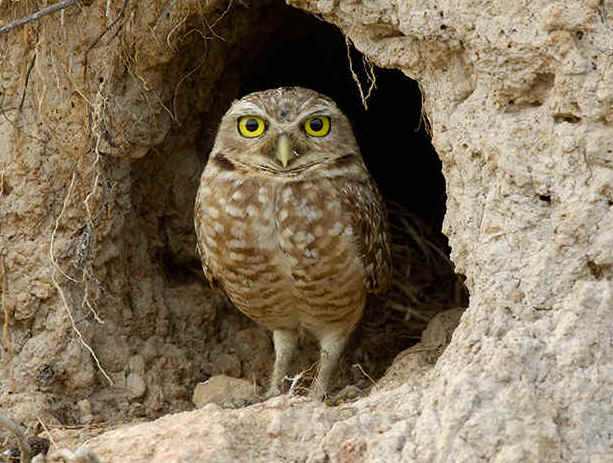 The
Birds
of
The
Birds
of
North America
Owls to Flycatchers
Part 4 of a List and
Photo Gallery
of North American Birds
compiled by Armas Hill
Noting those found during Focus On Nature Tours in Alaska, Arizona,
British Columbia, California, Colorado, Delaware, Florida, Iowa, Kansas, North
Carolina, Nebraska, Newfoundland, New Jersey, New Mexico, Oklahoma, Texas,
Virginia, Washington State, & Wyoming, including offshore pelagic trips
Birds found during FONT tours & pelagic trips have an (*).
PHOTO AT UPPER RIGHT: BURROWING OWL
Codes:
In the list that follows, birds found during FONT tours are noted, indicating the US state or Canadian
province & the months when found.
(The codes below relate to the United States unless indicated otherwise)
AK: Alaska
AZ: Arizona
BC: British Columbia, Canada (until 2001, during our West Coast Tours
in September)
CA: California
(during our September West Coast Tours)
CO: Colorado
DE: Delaware (including offshore pelagic trips from DE
and Delmarva land-birding and nature tours)
FL: Florida
IA: Iowa
(with our Nebraska Tours in March)
KS: Kansas (with our Colorado Tours in April)
MD: Maryland
(Delmarva Tours)
NC: North Carolina (including offshore pelagic trips and
spring & summer land-birding tours)
NE: Nebraska (tours in March & with our Colorado
tours in April)
NF: Newfoundland, Canada
NM: New Mexico (with our West Texas Tours in the spring &
our Arizona Tours in the late-summer)
OK: Oklahoma (with our Colorado Tours in April)
TX: Texas
VA: Virginia (Delmarva
Tours, and in conjunction with the NC Tour in the
spring)
WA: Washington State (during our September West Coast
Tours)
WY: Wyoming (with our Colorado Tours in April)
During FONT pelagic trips:
DEP: offshore from Delaware
CAP: offshore from California
NCP: offshore from North Carolina
NJP: offshore from New Jersey
WAP: offshore from Washington State
The months when the birds have been found are with the above codes.
(ac): north of the Arctic Circle
(DT): in the area of the Dry Tortugas
islands in Florida
(PI): at the Pribilof Islands in
Alaska
(USe):
endemic
to the USA
(USqe): quasi (or nearly) endemic to the USA
(USeb): endemic-breeder in USA
(USneb): near-endemic breeder in the USA
(NAi): species introduced into North America
(NAri): re-introduced species
(r/NA): rare in North
America, having occurred in both the United States & Canada
(r/US): rare in the United
States
(t): a globally threatened or rare species, designated by Birdlife International
(t1): critical (t2): endangered (t3): vulnerable
(nt): a near-threatened species globally
(ph): species with a photo in the FONT web-site
Links to Bird Groupings in this part of this List:
Owls
Nighthawks & Nightjars
Swifts Hummingbirds
Trogons
Kingfishers & Hoopoe
Woodpeckers Tityra
& Becards Flycatchers
Links to Other Parts of this North American Bird List:
Part #1: Grouse to Anhinga
Part #2: Condor to Shorebirds
Part #3: Jaegers to Cuckoos
Part #5: Shrikes to
Pipits Part #6: Olive Warbler to Buntings
Links to Lists of Birds of:
Alaska
Arizona California
Colorado
Delaware, Maryland, Virginia (Delmarva Peninsula)
North
Carolina Texas
Washington State
Links to
Lists & Photo Galleries of Other Nature, including North American:
Mammals
Butterflies, Dragonflies
Amphibians, Reptiles
Marine Life, inc Fish,
Crustaceans
Links to Information about Upcoming FONT Birding & Nature Tours;
in North America
by month in: 2015
2016 or:
by geographic location worldwide
Other Links:
Directory
of Photos in this Website
A Photo Gallery of Birds that in North America would be Rare

List of Birds:
OWLS
- American Barn Owl (*) (ph) ______
AZ:jul,aug
CA:sep DE:may NC:aug TX:apr WA:sep
Tyto furcata
The American Barn Owl has been part of the Barn Owl of
Eurasia & Africa, Tyto alba.
But Tyto furcata is a heavier
bird, with a larger and stouter head and body, and with much more powerful
talons.
SUBSPECIES IN NORTH AMERICA:
Tyto furcata pratincola ______ subspecies in
North and Central America; also on Hispaniola in the Caribbean
The longevity record of the American Barn Owl in the wild is 17
years, 10 months.
Outside North America, the Barn Owl, Tyto
alba, has been seen during
FONT tours in the Canary Islands, Hungary, Poland, Spain. During
tours in the 1990s it was found to be especially numerous in Spain.
South of the US:
The American Barn Owl, Tyto furcata,
has been found during FONT
tours in Argentina, Brazil, the Cayman Islands, Chile, Costa Rica,
the
Dominican Republic, Ecuador, Guatemala, Jamaica, Panama, Puerto Rico, Venezuela.
On Jamaica and Grand Cayman Island, it is the nominate
subspecies, Tyto furcata furcata.
On Grand Cayman Island, it is rare.
The Lesser Antilles Barn Owl, Tyto
insularis, has been found during FONT tours in Dominica,
Saint Lucia, and Saint Vincent.
The Galapagos Barn Owl, Tyto
punctatissima, has been found during FONT tours in the
Galapagos Islands, off Ecuador.
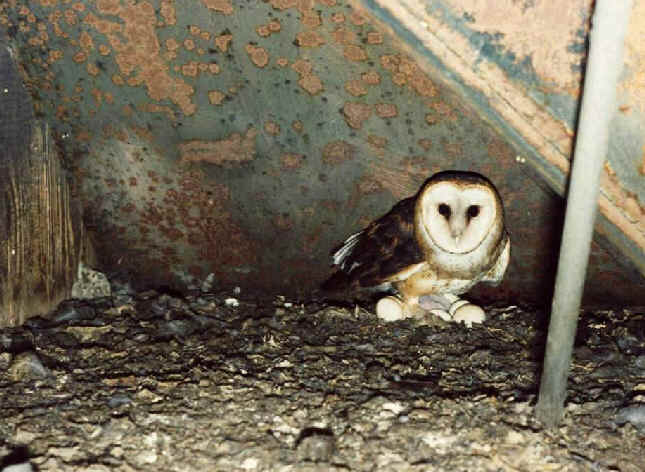
An American Barn Owl
(photo by Armas Hill)
- Flammulated Owl (*) ______
AZ:jul
Philoscops (formerly Otus) flammeolus
(monotypic, and the only species in its genus)
The longevity record of the Flammulated Owl in the wild is 13
years.
- Western Screech Owl (*) (ph) ______
AZ:aug
CA:sep TX:apr WA:sep
Megascops
(formerly Otus) kennicottii
SUBSPECIES IN NORTH AMERICA:
Megascops kennicottii aikeni ______
subspecies from the southwestern US to north-central Sonora in Mexico
Megascops kennicottii bendirei
______ subspecies from
Washington State & Idaho to southern California, east to Montana &
Wyoming, a pale gray subspecies
Megascops kennicottii cardonensis ______
subspecies in southern California, on the Pacific slope, rather dark
Megascops kennicottii kennicottii
______ subspecies from
southern Alaska to coastal Oregon, including Vancouver Island
Megascops kennicottii suttoni
______ subspecies from Rio Grande, Texas south into Mexico, the
darkest subspecies, described in 1941
Megascops kennicottii yumanensis
______ subspecies from the Colorado Desert & Baja California to
northwestern Sonora, Mexico, a pale-gray subspecies, described
in 1951
Some of these subspecies are known from just a few specimens and could be
morphs or examples of individual variation. More taxonomic review is
needed.
The longevity record of the Western Screech Owl in the wild is 12
years, 11 months.
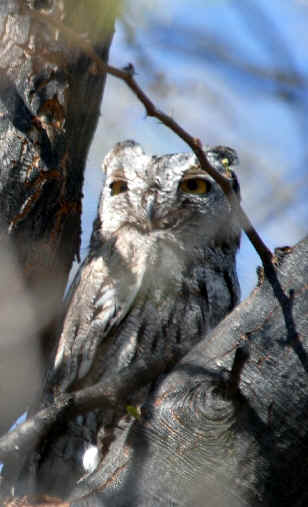
Western Screech Owl
(photo by Howard Eskin)
- Eastern Screech Owl (*) (ph) ______
DE:mar,may
NC:jun,aug TX:mar,may
Megascops (formerly Otus)
asio
SUBSPECIES IN NORTH AMERICA:
Megascops asio asio ______
subspecies in Virginia to Georgia, west to eastern Oklahoma, pale gray
Megascops asio floridanus ______ subspecies from
Florida to Louisiana and Arkansas
Megascops asio hasbroucki ______ subspecies from
Kansas to Oklahoma and Texas
Magascops asio maxwelliae ______ subspecies west of the Great
Lakes in the north-central US
Megascops asio naevius ______ subspecies in
southern Ontario & the northeastern US, with white below especially on
the belly
Megascops asio mccalli ______ subspecies from the
lower Rio Grande valley in Texas south into Mexico, has a gray morph more
dark-mottled above and a red morph paler
The longevity record of the Eastern Screech Owl in the wild is 20
years, 8 months.
The Eastern Screech Owl was described by Linnaeus in 1758.
South of the US, the Eastern Screech Owl has been found
during a FONT tour in Mexico.

Above & below: young gray-morph Eastern Screech Owls
Below; 4 of them with, yes, one facing away
(upper photo by Howard Eskin; lower photo by Doris Potter)
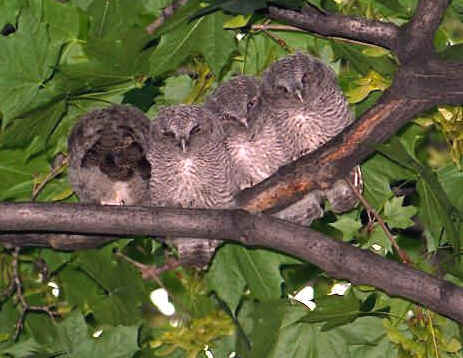
- Whiskered Screech Owl (*) ______
AZ:aug
Megascops
(formerly Otus) trichopsis
SUBSPECIES IN NORTH AMERICA:
Megascops trichopsis aspersus ______
subspecies from southeast Arizona to northern Mexico, occurs almost
entirely as an all-gray morph
South of the US, the Whiskered Screech Owl has been found during FONT tours in Mexico.
- Oriental Scops Owl ______ (r/US)
Otus sunia
The Oriental Scops Owl is a species of eastern Asia. There are 2 records of rufous morphs (of the
race japonicus) from the Aleutian islands, Alaska. A dried wing was found on
Buldir Island on June 5, 1977. A bird found alive on Amchitka Island on June
20, 1979 subsequently died. It became a specimen.
Outside North America, the Oriental Scops Owl has been found during
FONT tours in Japan.
- Great Horned Owl (*) (ph) ______
AZ:jan,jul,aug
CA:sep
CO:apr,jul DE:mar,apr,may KS:apr NC:may,jun,aug NE:mar NM:apr
TX:mar,apr,may WA:sep
Bubo virginanus
SUBSPECIES IN NORTH AMERICA:
Bubo virginanus heterocnemis ______ subspecies in eastern North
America, typically a dark morph, the pale morph being rare
Bubo virginanus occidentalis ______ subspecies
from Alberta to California, typically as a grayish morph
Bubo virginanus pacificus ______ subspecies in the southwestern
US
Bubo virginanus pallescens ______ subspecies
from southern California to northern Mexico, smaller and paler than some
other subspecies
Bubo virginanus saturatus ______ subspecies from Alaska to
California, mostly very dark
Bubo virginanus subarcticus ______ subspecies from British
Colombia & the Mackenzie Valley to western & northern Ontario, the
palest subspecies with white predominating in the plumage
Bubo virginanus virginanus ______ subspecies from Canada to
Florida
Bubo virginanus wapacuthu ______ subspecies in northern
and northeastern North America, very pale
The longevity record of the Great Horned Owl is 27 years, 9 months.
South of the US, the Great Horned Owl has been found
during FONT tours in Argentina, Brazil, Guatemala, Mexico, Venezuela.
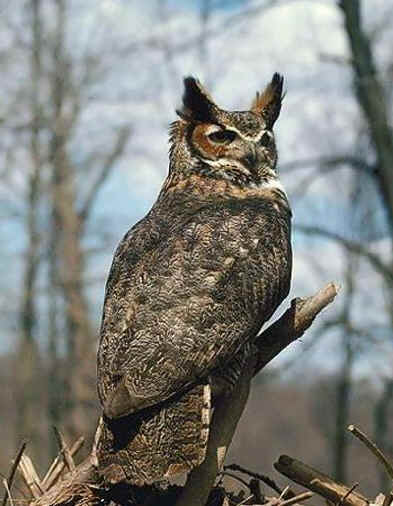
Above & below: Great Horned Owls
Above, an adult. Below, a juvenile.
(photos by Howard Eskin)
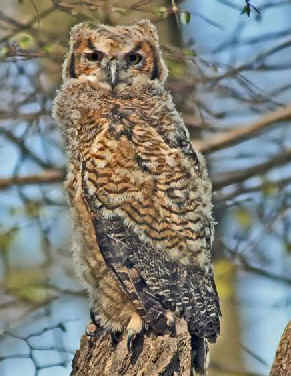
- Northern Pygmy Owl (*) ______
AZ:jul
CA:sep WA:sep
Glaucidium californicum (previously
Glaucidium gnoma, which is now the
Mountain Pygmy Owl of Mexico & Central America, reaching north into
southern Arizona & New Mexico)
SUBSPECIES IN NORTH AMERICA:
Glaucidium californicum californicum
______ subspecies from southeastern Alaska to California, very
dark
Glaucidium californicum pinicola
______ subspecies from Idaho & Montana south to New Mexico,
more spotted than the nominate and occurs in gray and red morphs
Glaucidium californicum swarthi
______ subspecies confined to Vancouver Island, British Colombia,
Canada
Glaucidium californicum pinicola
was previously considered a subspecies of the Mountain Pygmy Owl
(below).
Some DNA evidence supports its being a distinct species, but more research
regarding its biology, ecology, and taxonomy is needed.
- Mountain Pygmy Owl ______
Glaucidium gnoma (monotypic)
In addition to the Northern Pygmy Owl (above), two other
current species were previously conspecific with the Mountain Pygmy
Owl. These are the Baja Pygmy Owl, Glaucidium
hoskinsii and the Guatemalan Pygmy Owl, Glaucidium
cobanense.
However, the taxonomy of this group could use some more
study.
South of the US, the Mountain Pygmy Owl has been found during
FONT tours in Guatemala, Mexico.
- Ridgway's Pygmy Owl (ph) ______
(r/US)
(has been part of the Ferruginous Pygmy Owl)
Glaucidium ridgwayi
Generally, the wide-ranging Ferruginous Pygmy Owl has been a widespread Neotropical species
occurring in Central and South America.
However, with the latest taxonomy, the Ferruginous Pygmy Owl, Glaucidium
brasilianum, is now only in South America.
For a long time, Glaucidium ridgwayi has
been considered a subspecies of the Ferruginous Pygmy Owl, but it has
recently been separated on the basis of DNA data and vocal
differences.
Some further study of the Glaucidium brasilianum
complex is still needed.
In the US in southern Texas
and southern Arizona, Glaucidium ridgwayi inhabits saguaro deserts and woodlands.
Regarding Glaucidium ridgwayi
SUBSPECIES:
In Texas, Glaucidium ridgwayi ridgwayi
occurs to north to near Kingsville. That subspecies there is brownish.
The grayer subspecies in southern Arizona, Glaucidium
ridgwayi cactorum, is
rare, and considered endangered.
Glaucidium ridgwayi cactorum
______ subspecies restricted to western Mexico and southern Arizona
Glaucidium ridgwayi ridgwayi
______ subspecies from southern Texas and Mexico to northwestern
Colombia
South of the US, the Ridgway's Pygmy Owl has been found during FONT
tours in Belize, Costa Rica, Guatemala, Honduras, and Mexico.
South of the US, the Ferruginous Pygmy Owl has been found during FONT
tours in Argentina, Brazil, Ecuador, and Venezuela.
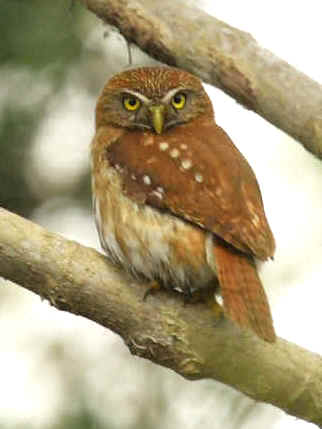
A Ridgway's Pygmy Owl,
photographed in Mexico
(photo by Dick Tipton)
- Elf Owl (*) ______ AZ:jul,aug
TX:apr
Micrathene whitneyi
SUBSPECIES IN NORTH AMERICA:
Micrathene whitney idonea ______ subspecies from
south Texas to central Mexico, grayer above than the nominate
Micrathene whitney whitney ______ subspecies in
the southwestern US and northern Mexico, wintering to central Mexico
The longevity record of the Elf Owl in the wild is 4 years, 11
months.
South of the US, the Elf Owl has been found during FONT
tours in Mexico (Sonora).
- Burrowing Owl (*) (ph) ______
AZ:jul,aug
CA:sep
CO:apr,jul FL:apr KS:apr NE:apr OK:apr
Athene (was Speotyto) cunicularia
SUBSPECIES IN NORTH AMERICA:
Athene cunicularia floridana ______ subspecies
in Florida
Athene cunicularia hypugaea ______ subspecies
from British Colombia east to Manitoba, south to Mexico, and more rarely
south to Panama
The longevity record of the Burrowing Owl in the wild is
11 years.
South of the US, the Burrowing Owl has been seen during
FONT tours in Argentina, Brazil, Chile, the Dominican Republic, Ecuador, Mexico (the Yucatan),
Paraguay, Venezuela.

Burrowing Owls
- Spotted Owl (nt) (*) (ph) ______
AZ:jul
Strix occidentalis
SUBSPECIES IN NORTH AMERICA:
Strix occidentalis caurina ______ subspecies
from British Colombia to northern California, a darker brown
Strix occidentalis lucida "Mountain, or
Mexican
Spotted Owl" ______
subspecies from Arizona to central Mexico, paler and with more white spots
Strix occidentalis occidentalis ______ subspecies
from Nevada to southern California
The longevity record of the Spotted Owl in the wild is
21 years.
Fragmentation of old-growth forests have facilitated the
spread of the Barred Owl (below) from east to west, as it seems to
adapt easily to more-open areas, and thus it is unfortunate that the larger
and more aggressive Barred Owl has been able to displace the Spotted
Owl.
With this expansion of the Barred Owl, there has been increased
opportunity for cross-breeding that threatens locally to overtake the pure Spotted
Owl gene pool.
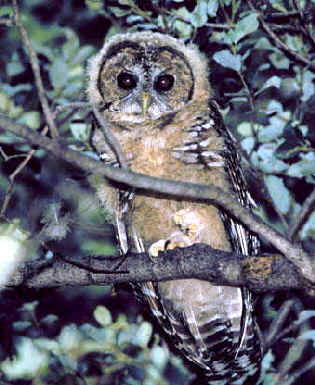
A young Spotted Owl photographed during a FONT
tour in southern Arizona,
the subspecies Strix occidentalis lucida, the
"Mexican Spotted Owl"
- Barred Owl (*) (ph) ______
DE:may
NC:jun,aug
Strix varia
SUBSPECIES IN NORTH AMERICA:
Strix varia georgica ______ subspecies
in the southeastern US from North Carolina to Florida, paler and a little
smaller than the nominate
Strix varia helveola ______
subspecies in Texas and the adjacent lowlands in Mexico, with a pale
cinnamon coloration
Strix varia varia ______ subspecies
from southeastern Alaska to northern California, and east across North
America, south to Texas and North Carolina
There is another subspecies in Mexico.
The longevity record of the Barred Owl in the wild is 18 years, 2
months.

Above & below: Barred Owls
(above photo by Marie Gardner; photo below by Ed Kendell)
The bird in the upper photo is the nominate, S. v. varia.
The one in the lower photo, photographed in South Carolina, appears to be
the paler subspecies, S. v. georgica.

- Great Gray Owl (ph) ______
Strix nebulosa
SUBSPECIES IN NORTH AMERICA:
Strix nebulosa nebulosa ______ subspecies from
central Alaska east through mush of southern Canada, and south to Idaho,
Wyoming, and northeastern Minnesota; rarely further south during irruptions
Strix nebulosa yosemitensis ______ subspecies in
the Sierra Nevada mountains in California, recently separated from the
nominate based on DNA analysis, described in 2010
The longevity record of the Great Gray Owl in the wild is 15
years, 11 months.
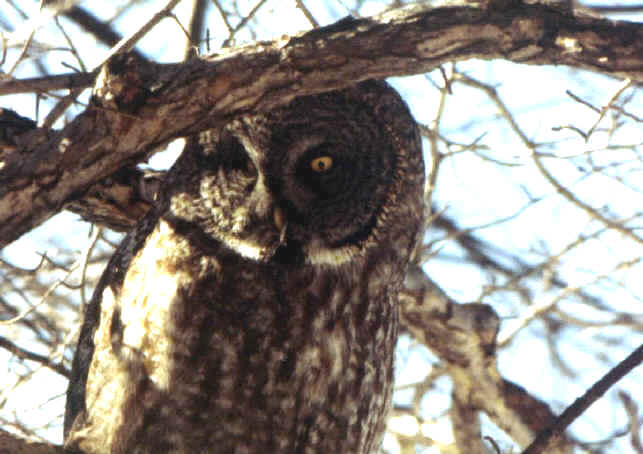
A Great Gray Owl
(photo by Armas Hill)
- Mexican Wood Owl ______ (r/US)
Strix
(or Cicabba) squamulata
The Mexican Wood Owl has been part of the Mottled
Owl, Strix virgata, now said to be a
South American species.
The Mexican Wood Owl ranges from northwestern & northeastern Mexico south
into northwestern South America. There is a road-killed specimen from near the
Bentson-Rio Grande State Park, in southern Texas, from February 23, 1983.
South of the US, the Mexican Wood Owl has been found during FONT tours
Belize, Costa Rica, Ecuador, Guatemala, Mexico, and
Panama. The
Mottled Owl has been found during FONT tours in Brazil.
- Stygian Owl ______ (r/US)
Asio stygius
The Stygian Owl occurs from Mexico south into South America, and locally in
the West Indies on Hispaniola & Cuba. It is a forest-dwelling nocturnal owl,
rather secretive.
Twice, found roosting and photographed at the Bentson-Rio Grande Valley
State Park, in southern Texas, on December 9, 1994 & December 26, 1996.
The 1994 bird was first thought to be a Northern Long-eared Owl.
South of the US, the Stygian Owl has been found during a FONT
tour in Guatemala.
- Northern Long-eared Owl (*) ______
NE:mar
Asio otus
SUBSPECIES IN NORTH AMERICA:
Asio otus tuftsi ______ subspecies from British
Colombia, Canada to northwestern Mexico, more pale & gray than A.
o. wilsonianus, subspecies
described in 1948
Asio otus wilsonianus ______ subspecies in
Canada are the US, except in the West
Other species of "southern" Long-eared Owls are in
Africa and Madagascar.
The longevity record of the Northern Long-eared Owl in the wild
is 27 years, 9 months.
The Northern Long-eared Owl was described by Linnaeus in 1758.
Outside North America, the Northern Long-eared Owl has
been found during FONT tours in Bulgaria, Hungary, Japan, Poland..
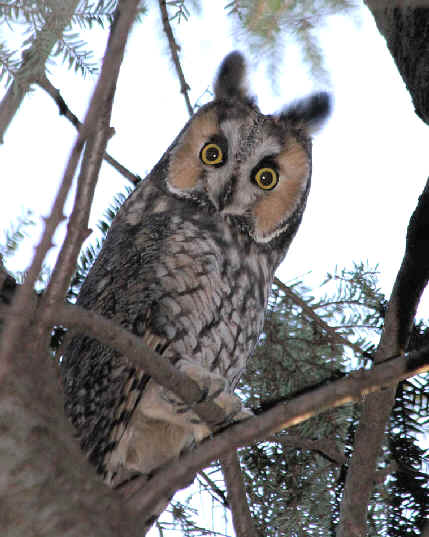
Above & below: Northern Long-eared Owls
(upper photo by Doris Potter;
the lower photo, an older picture in black-and-white, by Alan Brady)

Below: a drawing of a Long-eared Owl by Charles Gambill

-
Short-eared Owl (*) (ph) ______ AK:may,jun
(PI) FL:apr (DT) WA:sep
Asio flammeus
SUBSPECIES THAT OCCUR IN NORTH AMERICA:
Asio flammeus domingensis ______
subspecies on the Caribbean islands of Cuba, Hispaniola, and Puerto Rico;
it has occurred at the Dry Tortugas, an offshore island in southern Florida
Asio flammeus flammeus _____ subspecies
throughout the Northern Hemisphere
Asio flammeus domingensis
is smaller than Asio flammeus flammeus,
and has very fine streaks on the belly and a darker ruff.
The West Indian subspecies, Asio flammeus
domingensis, is sometimes said to be a full species due to
its plumage and vocalizations.
The longevity record of the Short-eared Owl in the wild is 20
years, 9 months.
Outside North America, the Short-eared Owl has been seen
during FONT tours in Hungary, Iceland, Japan, Sweden, and south of
the US in Brazil, Chile, and Venezuela.
Outside North America, the Galapagos Short-eared Owl,
Asio galapagoensis, has been seen during FONT torus in the
Galapagos Islands, off Ecuador.
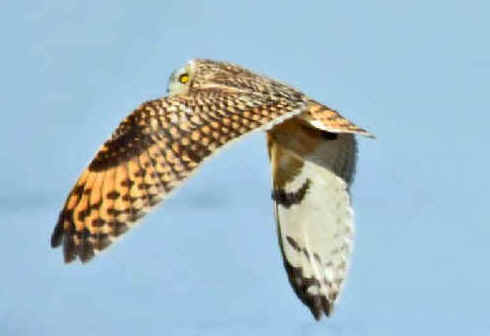
Above & below: Short-eared Owls in flight
(upper photo by Howard Eskin, lower photo by Kim Steininger)
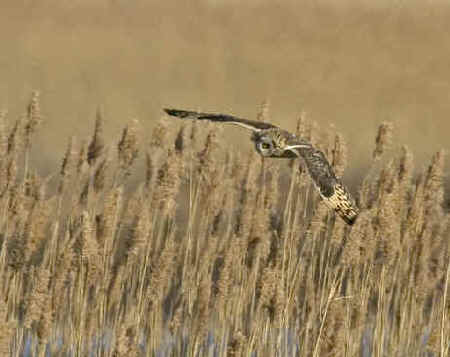
- Snowy Owl (*) (ph) ______
AK:may,jun (PI)
Bubo
(formerly Nyctea) scandiacus (monotypic)
The longevity record of the Snowy Owl in the wild is 11
years, 7 months.
The Snowy Owl was described by Linnaeus in 1758.
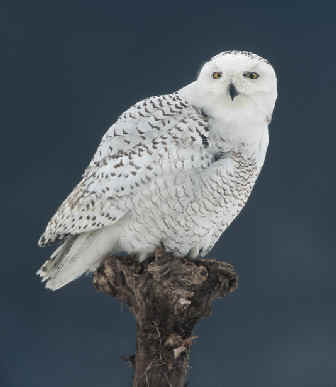
Snowy Owls
(above photo by Paul Leverington; below photo by Kim Steininger)
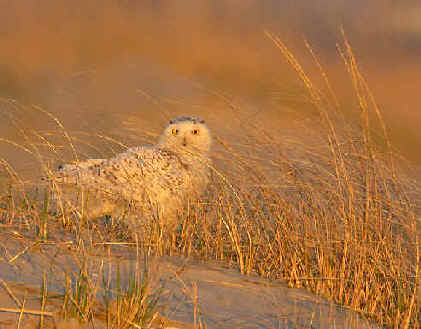
- Northern Hawk Owl (*) ______
AK:may,jun
Surnia ulula
SUBSPECIES IN NORTH AMERICA:
Surnia ulula caparoch ______
subspecies from Alaska across southern Canada to the extreme northern US;
this subspecies darker than the two in Eurasia
The longevity record of the Northern Hawk Owl in the wild is 16
years, 2 months.
The Northern Hawk Owl was described by Linnaeus in 1758.
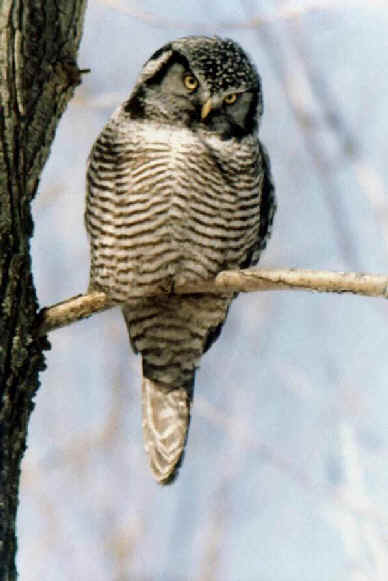
Above & below: Northern Hawk-Owls
(upper photo by Armas Hill in 1979;
lower photo, in black-and-white, by Alan Brady in 1991)
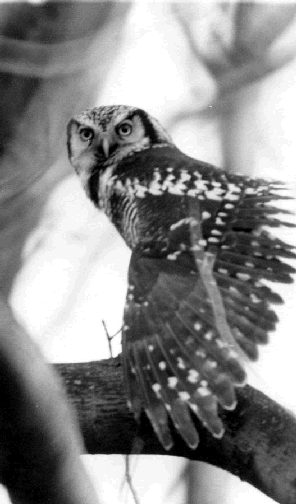
- Boreal Owl (*) ______ AK:may,jun
Aegolius funereus
SUBSPECIES IN NORTH AMERICA:
Aegolius funereus richardsoni ______ subspecies
from Alaska across Canada; in western North America in the Rocky Mountains
south to New Mexico
The Boreal Owl is called the Tengmalm's Owl in Europe.
The longevity record of the Boreal Owl in the wild is 15
years.
The Boreal, or Tengmalm's Owl was described by Linnaeus in 1758.
Outside North America, the Tengmalm's, or Boreal, Owl has
been found during FONT tours in Poland, Slovakia.
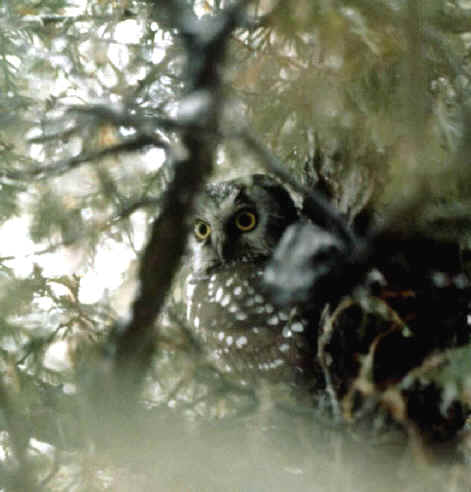
Above & below: Two Photos of a Boreal Owl
(photographed by Armas Hill in 1979)

- Northern Saw-whet Owl (*) (ph) ______
AK:jun
Aegolius acadius
SUBSPECIES:
Aegolius acadius acadius
______ subspecies from Alaska to the Mexican highlands, and east
across southern Canada and in the northern US
Aegolius acadius brooksi
"Queen Charlotte Owl" ______ subspecies on Queen
Charlotte Island, British Colombia, Canada; very dark and much less spotted
above than the nominate, and with a rich orange-buff
below
The longevity record of the Northern Saw-whet Owl in the wild is 10
years, 4 months.
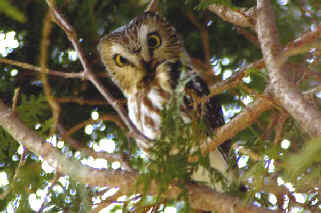
Above & below: Northern Saw-whet Owls
Above, an adult; below, one juvenile & three juveniles
(upper photo by Andy Ednie; lower photos by Alan Brady)
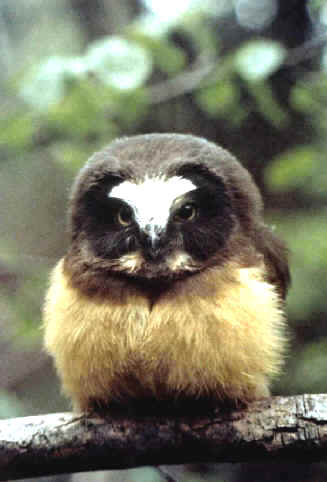
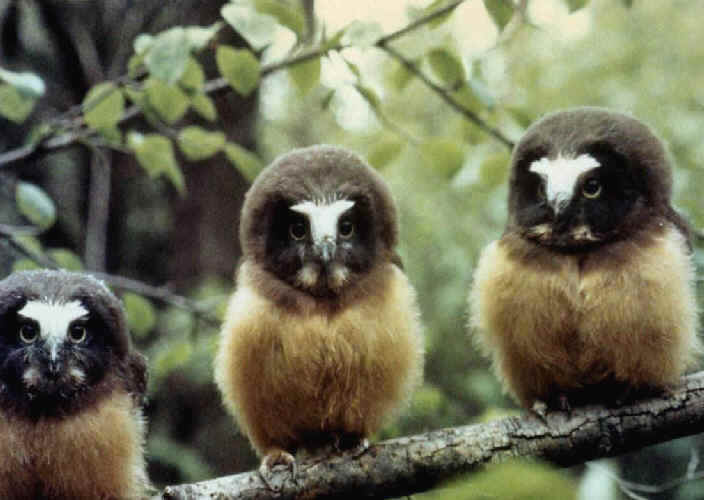
- Japanese Hawk Owl (or Northern
Boobook) ______ (r/US)
Ninox japonica
The subspecies Ninox japonica florensis
(which some say should be split to be a species) occurs as a summer resident
in far-eastern Russia, northern Korea, and northeastern & central China.
There are two other, more-southerly subspecies.
The Japanese Hawk Owl has been part of the traditional and
wide-ranging Brown (or Oriental) Hawk Owl, Ninox
scutulata, which has been an
extremely polytypic species, having at least 10 subspecies in 3
groups.
In Alaska, on Saint Paul Island in the Pribilofs, a Japanese Hawk Owl
was found roosting in crab pots in the harbor on August 27, 2007. The
following year, also in Alaska, one was found dead on Kiska Island in the
western Aleutians on August 1, 2008.
Outside North America, the Japanese (formerly Brown)
Hawk Owl has been found during
FONT tours in Japan.
NIGHTHAWKS & NIGHTJARS
- Lesser Nighthawk (*) ______
AZ:jul,aug
NM:apr
TX:apr,may
Chordeiles acutipennis
South of the US, the Lesser Nighthawk has been seen during
FONT tours in Belize, Brazil, Costa Rica, Ecuador, Guatemala, Honduras, Mexico,
Panama, Venezuela.
- Common Nighthawk (*) (ph) ______
AZ:jul,aug
CA:sep CO:jul DE:may FL:apr (DT) NC:jun,jul,aug TX:apr,may WA:sep
Chordeiles minor
South of the US, the Common Nighthawk has been found
during FONT tours in Brazil, the Dominican Republic, Guatemala, Mexico, Panama.
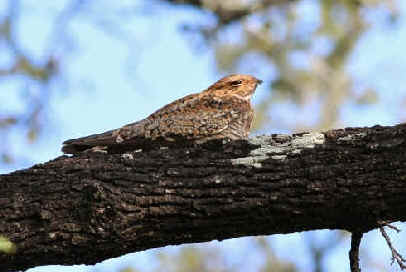
A Common Nighthawk
photographed in Texas
(photo by Rhett Poppe)
- Antillean Nighthawk (*) ______
FL:apr (DT)
NC:aug (r/NC)
Chordeiles gundlachii
A West Indian species that occurs regularly in the summer on the Florida
Keys. It is, on occasion, seen at the offshore Dry Tortugas and on the
southeast Florida mainland. It has occurred rarely in Louisiana and on the
Outer Banks of North Carolina.
An Antillean Nighthawk was with Common Nighthawks in the area of dunes at
Cape Hatteras, North Carolina in August 1994. It was both seen and heard
during a FONT tour.
South of the US, the Antillean Nighthawk has been seen during
FONT tours in the Cayman Islands, the Dominican Republic, Jamaica,
Puerto Rico.
- Pauraque (*) (ph) ______ TX:apr
Nyctidromus albicollis merrilli
South of the US, the Pauraque has been found during FONT
tours in Argentina, Belize, Brazil, Costa Rica, Ecuador, Guatemala, Honduras, Mexico, Panama,
Venezuela.
- Common Poorwill (*) ______
AZ:jul,aug
CO:jul NM:apr TX:apr,may WA:sep
Phanaenoptilus n. nuttallii
South of the US, the Common Poorwill has been found during
FONT tours in Mexico (Sonora).
- Chuck-will's-widow (*) ______
DE:may
FL:apr
NC:may,jun TX:may
Antrostomus
(formerly Caprimulgus) carolinensis
South of the US, the Chuck-will's-widow has been seen
during FONT tours in the Dominican Republic, Puerto Rico.
- Eastern Whip-poor-will (*) ______
DE:may NC:jun
Antrostomus
(formerly Caprimulgus) vociferus
- Mexican Whip-poor-will (*) ______
AZ:jul
Antrostomus (formerly Caprimulgus) arizonae
South of the US, the Mexican Whip-poor-will has been found
during FONT tours in Guatemala, Mexico.
- Buff-collared Nightjar ______
Antrostomus
(formerly Caprimulgus) ridgwayi
South of the US, the Buff-collared Nightjar has been found during
FONT tours in Guatemala.
- Gray Nightjar (ph) ______
(r/US)
Caprimulgus indicus
The Gray Nightjar is a migratory Asian species that was formerly conspecific
with the more-southerly Jungle NIghtjar. A specimen, not in the best
condition, of the race jotaka, was found on Buldir Island, Alaska, on May
31, 1977.
Outside North America, the Gray Nightjar has been seen during
FONT tours in Japan, including Hegura Island.
SWIFTS
- American Black Swift (*) ______ CA:sep
CO:jul
Cypseloides niger borealis
South of the US, the American Black Swift has been found during
FONT tours in the Dominican Republic, Guatemala, Jamaica, Puerto Rico,
Saint Lucia, Saint Vincent.
- Chimney Swift (*) ______ DE:may
MD:may NC:may,jun,jul,aug
TX:may
Chaetura pelagica
South of the US, the Chimney Swift has been seen
during FONT tours in Brazil (Amazonian), the Cayman Islands (during migration),
Chile (far-north), Ecuador, Honduras (during migration), Mexico.
- Vaux's Swift (*) ______ CA:sep
WA:sep
Chaetura vauxi
South of the US, the Vaux's Swift has been seen during FONT tours
in Belize, Costa Rica, Guatemala, Honduras, Mexico, Panama, Venezuela.
- White-throated Swift (*) ______
AZ:jul,aug
CA:sep
CO:apr,jul
NM:apr TX:apr,may
Aeronautes saxatalis
South of the US, the White-throated Swift has been seen
during FONT tours in Guatemala, Mexico.
- White-collared Swift ______ (r/NA)
Streptoprocne zonaris
The White-collared Swift is a widespread species of Central & South America that also is locally
found in the West Indies. It has occurred as a vagrant at various places in
the US and southern Canada.
South of the US, the White-collared Swift has been seen during FONT tours in
Argentina, Belize, Brazil, Costa Rica, the
Dominican Republic, Ecuador, Guatemala, Honduras, Jamaica, Mexico, Panama,
Venezuela.
- White-throated Needletail ______
(r/US)
Aeronautes saxatalis
The White-throated Needletail is an Asian species. It occurs rarely in the spring in the western Aleutian
Islands, Alaska.
Outside North America, the White-throated Needletail has been seen
during FONT tours in Japan (on Okinawa).
.
- Pacific Swift ______ (r/NA)
Apus pacificus
Another name for Apus pacificus
is the Asian White-rumped Swift. It has occurred rarely on western Alaskan islands.
Outside North America, the Pacific Swift has been seen during FONT
tours in Japan, including Hegura Island.
- Common Swift ______ (r/NA)
Apus apus
The Common Swift breeds in Europe and winters in
Africa. It has occurred, as a rarity, at Miquelon Island (actually a part of
France) in the Atlantic Ocean off the east coast of Canada. Also It has been
found in Bermuda.
Oddly, there are said to have been 2 records at the Pribilof Islands,
Alaska. "Oddly" because the species does not occur in east
Asia. But birds do fly! And swifts, especially, are fliers.
Outside North America, the Common Swift has been found during
FONT tours in Andorra, Bulgaria, France, Hungary, Poland, Slovakia,
Spain, Sweden, Turkey.
- Antillean Palm Swift ______ (r/US)
Tachornis phoenicobia
The Antillean Palm Swift is a species of the West Indies, particularly Cuba and Hispaniola. 2 were
present and photographed at Key West, Florida from July 7 to August 13,
1972.
South of the US, the Antillean Palm Swift has been seen during FONT
tours in the Dominican Republic, Jamaica.
HUMMINGBIRDS
- Broad-billed Hummingbird (*) (ph)
______ AZ:jul,aug,sep
Cynanthus latirostris
North of Mexico, this species normally ranges in southern Arizona.
Otherwise, there have been fall and winter occurrences in southern
California, and along the Gulf Coast. During 1 winter, 4 were banded in
Louisiana. The species has also occurred as a rarity, from late-summer
through the spring, in southern Nevada, New Mexico (except in the Peloncillo
Mountains & the Guadalupe Canyon where it more regular), and Texas. And
it has occurred as a vagrant in these US states and Canadian provinces:
Illinois, Michigan, New Brunswick, Ontario, Oregon, South Carolina, Utah,
Wisconsin.
South of the US, the Broad-billed Hummingbird has been seen
during FONT tours in Mexico.
- Buff-bellied Hummingbird (*) ______
TX:may
Amazilia yucatanensis
The Buff-bellied Hummingbird breeds in the US in south Texas. After nesting, a small
number move northward & eastward along the US Gulf Coast. Some winter
eastward to Florida, occurring there from October to March. The few winter
records away from the coastal plain of the Gulf of Mexico include those in
central Texas and more rarely in Arkansas, Mississippi, and
Alabama.
South of the US, the Buff-bellied Hummingbird has been seen
during FONT tours in Guatemala, Mexico.
- Berylline Hummingbird (*) ______
(r/US) AZ:jul,aug,sep
Amazilia beryllina
The Berylline Hummingbird is a species mostly of northern Central America, occurring in Mexico and
south to Honduras. It is a very rare summer visitor to the mountains of
southeast Arizona, where it has rarely bred. It is also occurs rarely in southwestern New
Mexico (in the Guadalupe Canyon) and in west Texas (in the Big Bend National
Park & in the Davis Mountains).
South of the US, the Berylline Hummingbird has been seen during FONT
tours in Guatemala, Honduras, Mexico.
- Violet-crowned Hummingbird (*) (ph)
______
(r/US) AZ:jul,aug,sep
Amazilia violiceps
The Violet-crowned Hummingbird is nearly a Mexican endemic, but its northern breeding
range does extend into southeastern Arizona and southwestern New Mexico. In
southeast Arizona, breeding is in the areas of the Sonoita Creek and the
Huachuca & Chiricahua Mountains. A few individuals spend the winter near
feeders in southeast Arizona. But mostly the species moves into Arizona and
New Mexico in June.
It occurs as a vagrant in central Arizona (August, October), in California
(July to December, and March & May), and in west Texas (March, July,
December), southern Texas (May, October), and the upper Texas Gulf Coast
(March).
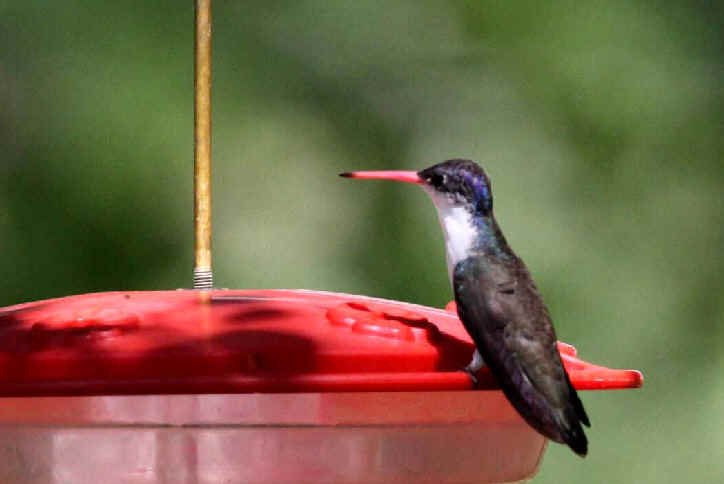
A Violet-crowned Hummingbird photographed during
a FONT tour
in Arizona in August 2010
- Cinnamon Hummingbird (ph) ______
(r/US)
Amazilia rutila
The Cinnamon Hummingbird ranges in lowlands from Sinaloa and the Yucatan Peninsula
in Mexico south to Costa Rica. In the United States, it has occurred at
Patagonia, Arizona July 21 to 23, 1992, and at Santa Teresa in New Mexico
from September 18 to 21, 1993.
South of the US, the Cinnamon Hummingbird has been seen during FONT
tours in Belize, Costa Rica, Guatemala, Honduras,
Mexico.
- Blue-throated Mountain-gem (*) (ph) ______
AZ:jul,aug,sep
Lampornis clemenciae
Lampornis clemenciae
has also been called the Blue-throated Hummingbird.
North of Mexico, the Blue-throated Hummingbird (as it has most often
been called in the US) is primarily a "sky island"
mountain species in western Texas, southern New Mexico, and southeastern
Arizona.
It has occurred as a a vagrant to central Arizona, central New
Mexico, Colorado (July to August), and in parts of Texas (mostly in the
fall): the Edwards Plateau, the Gulf Coast, the lower Rio Grande Valley, and
the Panhandle. Vagrants have also been in: California (in the summer),
Louisiana (during fall & spring), North Dakota (in June), South Carolina
(in August), and in Utah (in August).
South of the US, the Blue-throated Mountain-gem has been seen
during FONT tours in Mexico.
- White-eared Hummingbird (*) (ph)
______
(r/US) AZ:jul,aug,sep
Hylocharis leucotis
North of Mexico and northern Central America, the White-eared
Hummingbird occurs mostly
in southeastern Arizona, in the Huachuca and Chiricahua Mountains. It has
bred in southern Arizona. Generally it arrives in Arizona in mid-April to
May, and departs August to October.
It also occurs as rarity, from June to October, in southwestern &
north-central New Mexico, and in western & central Texas, including in
the Davis, Guadeloupe, and Chisos Mountains. Most records north & east
of the breeding range are from late-June to August. There is evidence of
some post-breeding movement.
A female that wintered in coastal Mississippi, from November 1995 to January
1996, was extraordinary.
South of the US, the White-eared Hummingbird has been seen during
FONT tours in Guatemala, Honduras, Mexico.
- "Rivoli's" Magnificent Hummingbird
(*) (ph) ______ AZ:jul,aug,sep
Eugenes fulgens
North of Mexico and Central America, the Magnificent
Hummingbird is primarily a
"sky island" mountain species in western Texas, southern New
Mexico, and southeastern Arizona.
Young males are often highly nomadic, Banded birds have traveled hundreds of
miles between mountain ranges during a season. Such migration is through
lower elevations, especially foothills, in the spring and fall.
Away from the US breeding range, there have been occurrences in Colorado
(from May to October), and less so in: Alabama (September to February),
Arkansas (in July), California (in April), Georgia (in the winter),
Minnesota (in July), Nevada (in June), Utah (in July), Wyoming (in June
& July), and in southern Texas (in September).
South of the US, the Magnificent Hummingbird has been seen during
FONT tours in Costa Rica, Guatemala, Mexico, Panama.
- Lucifer Sheartail (*) (ph) ______
AZ:jul,aug
TX:apr,may
Calothorax lucifer
Calothorax lucifer
has commonly been called the Lucifer Hummingbird.
Calothorax lucifer
is nearly a Mexican endemic, but its northern
breeding range does extend into west Texas, where it can be fairly common in
the Big Bend National Park. The species occurs rarely in southeast Arizona
& southwest New Mexico, and has been a vagrant at some places, other
than at its usual haunts, in Texas, New Mexico, and Arizona. In Texas,
vagrants have been in the Edwards Plateau and Guadeloupe Mountains, and in
El Paso, Del Rio, Rockport, and Beeville. Vagrants in New Mexico have been in
Gila and Silver City; in Arizona in Tucson.
South of the US, the Lucifer Sheartail has been seen during FONT
tours in Mexico.
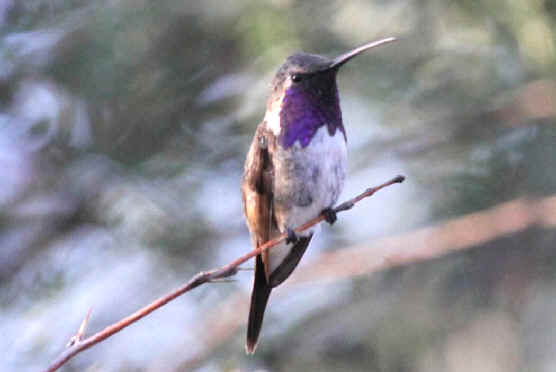
Two photographs of Lucifer Sheartails during the
FONT tour in southern Arizona
in September 2010. Above: a male; below: a female
(photos by Marie Gardner)
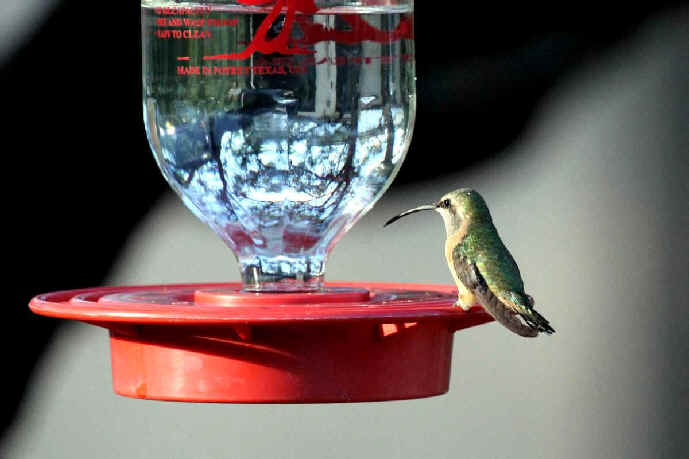
- Ruby-throated Hummingbird (*) (ph)
______ DE:may
FL:apr
(DT) NC:may,jun,aug TX:apr,may
Archilochus colubris
Out-of-range occurrences in the US have been in: Alaska (in
June), California (in August, September), Colorado (in April, May, July),
and New Mexico (in October).
South of the US, the Ruby-throated Hummingbird has been seen
during FONT tours in Costa Rica, Guatemala, Honduras, Mexico, Panama
(where rare).
- Black-chinned Hummingbird (*) (ph)
______ AZ:jul,aug,sep
CO:apr,jul
NM:apr TX:mar,apr,may
Archilochus alexandri
(monotypic)
This species normally occurs in the western US and in parts of central
& western Mexico. East of that range, some individuals winter along the
Gulf Coat of the US from Texas east to Georgia and Florida. Some winter in
California.
Out-of-range occurrences have been in these US states and Canadian
provinces: Alberta (in July), Kentucky (in fall-winter) New Jersey (in
the fall), North Carolina (in the fall & spring), Ontario (in May),
South Carolina (in the fall & winter), South Dakota (in the fall),
Tennessee (in fall-winter).
South of the US, the Black-chinned Hummingbird has been seen
during FONT tours in Mexico (Sonora).
- Anna's Hummingbird (*) (ph) ______
AZ:jan,jul,aug,sep
CA:sep
Calypte anna
A species of western North America, but vagrants can occur
almost anywhere, most commonly in the fall & winter.
Out-of-range occurrences have been in these US states and Canadian
provinces: Alabama (in November), interior Alaska (in September), Alberta
(from June to October), Arkansas (in fall-winter), Colorado (from May to
December), Delaware (in November), Florida (in fall-winter), Georgia (in fall-winter), Idaho (from
September to May), Illinois (in fall-winter), Kansas (in fall-winter),
Michigan (December to April), Minnesota (in fall-winter), Missouri (October
to February), Mississippi (November to January), Montana (June to November),
North Carolina (in fall-winter), New York (October to December), Oklahoma
(in winter), Pennsylvania (in winter), Saskatchewan (from July to October), South Carolina (in
winter), Tennessee (in January), in northern & eastern Texas (from July
to March), Utah (in the fall), Wisconsin (from August to January).
The migration of the Anna's Hummingbird is not well understood. It
does not appear to migrate in the "traditional sense". Year-round
presence is some areas may well be due to breeding birds being replaced by
migrants from other areas.
Large numbers of Anna's in the mountains of Arizona in the
non-breeding season (July to October) have long been assumed to come from
California, yet of the thousands of hummingbirds that have been banded in
California and Arizona, ONLY ONE is has been shown to have traveled between
the 2 states!
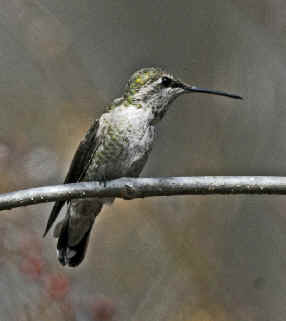
A female Anna's Hummingbird
(photo by Howard Eskin)
- Costa's Hummingbird (*) (ph) ______
AZ:jul,aug,sep
Calypte costae
A species of desert scrub normally in the southwestern US and
northwestern Mexico. Part of the population that breeds in the resident
range migrates south in the winter along the Pacific coast of Mexico.
Vagrants have occurred in these US states and Canadian provinces: Alaska
(from July to October), Alberta (in August), British Columbia (from April
to June), Colorado (in May), Kansas (in November), western Texas (from
September to January & in April), in central & southern Texas (from
January to March), western Washington State (from August to October).
- Calliope Hummingbird (*) (ph) ______
AZ:jul,aug,sep
Selasphorus (formerly Stellula) calliope
A species that breeds in montane coniferous forests in parts
of the western US and southwestern Canada. Most winter in southwestern
Mexico. Some winter, however, along the Gulf Coast in the US, from Texas to
northwestern Florida, mainly in Louisiana. More rarely, some winter in west
Texas and in Arizona.
Otherwise, vagrants have occurred in these US states and one Canadian
province: northern Alabama (in November), Arkansas (in November &
December), central Florida (in March & April), northern Georgia (in the
winter), Kansas (in July & August), Minnesota (in November &
December), North Carolina (from October to March), Nebraska (from June to
August), New Jersey (in November), Pennsylvania (in November), Saskatchewan (in July & August),
South Carolina (from December to April), South Dakota (in August), Tennessee
(from November to April) and in western & central Texas.
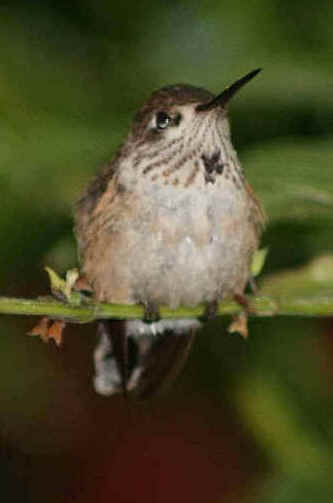
Above & below: A Calliope Hummingbird in
Pennsylvania, the 2nd in the state,
in November 2012. Below, feeding at Pineapple Sage.
(photos by Joe Flood)

- Bumblebee Hummingbird ______
(r/US)
Atthis heloisa
The Bumblebee Hummingbird is a Mexican species. 2 female specimens are said to have been
collected in southern Arizona, in the Huachuca Mountains, in July 1896.
- Broad-tailed Hummingbird (*) (ph) ______ AZ:jul,aug,sep
CO:apr,jul
NM:apr TX:apr,may
Selasphorus platycercus
(monotypic)
A species that summers, and breeds, mostly in the western United States,
and winters mostly in Mexico. A small number winter along the Gulf Coast of
the southeast US.
Otherwise, out-of-range occurrences have been in these US states and one
Canadian province: northern Arkansas (in November & December), British
Columbia (in July), Delaware (in the winter), Florida (in January &
February), Georgia (in the fall-winter), Illinois (in November), Indiana (in
the winter), Kansas (from June to September), Michigan (from August to
winter), Mississippi (in fall-winter), Nebraska (in August & September),
New Jersey (in November), Oregon (from May to August), South Dakota (from
June to September), in eastern & central Texas, and in Washington State
(in August).
South of the US, the Broad-tailed Hummingbird has been seen
during FONT tours in Guatemala, Mexico.
- Rufous Hummingbird (*) (ph) ______
AK:jun AZ:jul,aug,sep
Selasphorus rufus
This species is a long-distance migrant, summering, and
breeding, as far north as southern Alaska, and wintering mostly in Mexico.
Some, however, winter in the US, especially in the Southeast notably along
the Gulf Coast, mostly in Louisiana, Mississippi, Alabama, and Texas. A few
also winter in the US in coastal southern California.
During the summer of 2010, a second-year female Rufous Hummingbird
that had been banded the previous winter in Florida was recaptured in
Alaska, on an island in the Prince William Sound, 3,543 miles from where the
bird was in Florida. That is the longest documented distance traveled by any
hummingbird of any species.
The Rufous Hummingbird seems strongly prone to wandering during it southbound migration
in the fall. It has occurred in ALL of the US states east of the Rocky
Mountains, and in most of the Canadian provinces. And so it can appear
almost "anywhere", and is usually discovered at feeders.
In the southbound Rufous Hummingbird migration, adult males travel
first, with adult females following about 1 to 2 weeks later. The migration
of the immature birds is the latest and the most drawn-out, occurring up to
a month after that of the adult female.
The Rufous Hummingbird is the only hummingbird that occurs, on
occasion, in the Old World. In the spring, migratory overshoots have reached
as far into Russian Siberia as the Chukotski Peninsula.
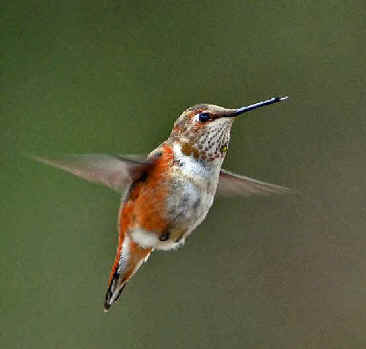
Above & below: 3 photos of Rufous Hummingbirds
Above: a 1st-year male; below: 2 immature female Rufous Hummingbirds
(photos by Howard Eskin)
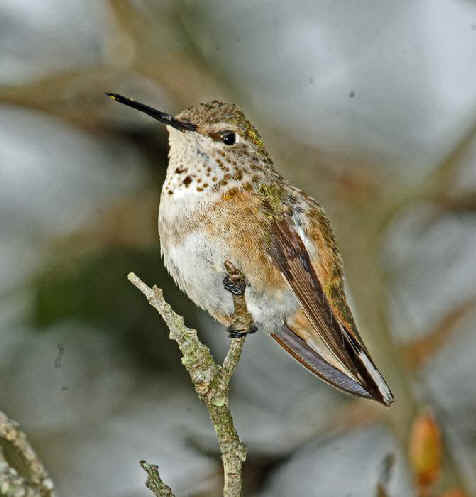
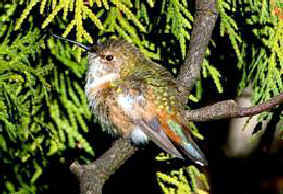
- Allen's Hummingbird (*) ______
AZ:jul,aug
Selasphorus sasin
This species, a close relative of the Rufous Hummingbird, has one
of the most restricted breeding ranges of any North American hummingbird,
being confined from the Pacific Coast of southern California north to
southern Oregon. Although its habitat has been strongly altered by human
activity, the bird has adapted well to urban and suburban environments.
Outside its breeding range, the Allen's Hummingbird is rare, but
regular, in southern Arizona, and has occurred more rarely in New Mexico,
west Texas, Utah, and Nevada. Some winter rarely along the Gulf Coast of the
US.
Fall-winter occurrences in eastern US states have been in: Delaware,
Florida, Georgia, Louisiana, Massachusetts, Mississippi, New Jersey,
Pennsylvania, Tennessee, Texas, and Virginia.
In its limited breeding range, there are 2 subspecies. One, sedentarius,
apparently originated on the offshore Channel Islands, and colonized, during
the 20th Century, the nearby California mainland. It has recently spread,
both north and south along the coast. Although this subspecies is
essentially nonmigratory, an Allen's Hummingbird specimen from
Louisiana was identified as sedentarius.
The Allen's Hummingbird in the photo below is a first-year male,
determined by the measurement of the R5 feather and some other
characteristics during an in-hand inspection. The bird, in Bucks County,
Pennsylvania, in November 2012, had been thought to be the nearly-identical Rufous
Hummingbird.
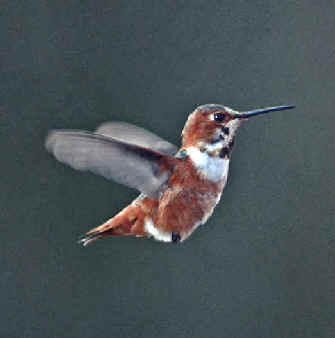
Above & below: Allen's Hummingbirds
Above: an immature male; below: an adult female
(photos by Howard
Eskin)
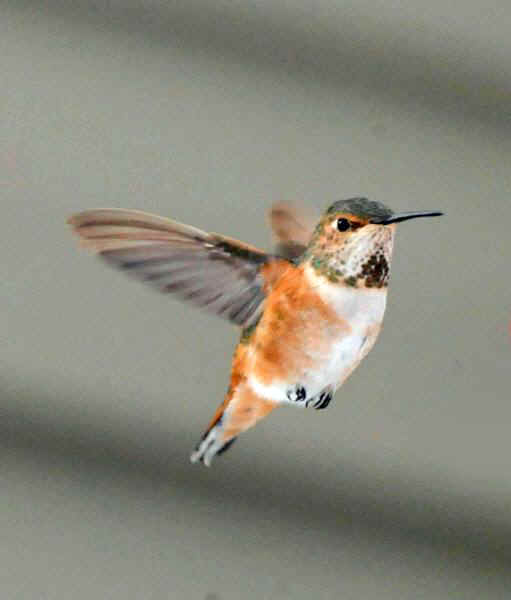
- Green Violetear (ph) ______
(r/NA)
Colibri thalassinus
A Neotropical species, most often in the highlands, from Mexico south to
northern South America. Most US records have been in the Hill Country of
Texas, where it is nearly an annual occurrence. It has also occurred rarely
in eastern North America and elsewhere in the US.
There have been more than 30 records of the Green Violetear in
eastern Texas since 1961, with as many as 4 during one season. These have
been in the Edwards Plateau (or the "Hill Country" as just noted),
and along Gulf Coast and in the lower Rio Grande Valley. All of the
occurrences of the species north of Mexico in the spring have been in Texas.
Accepted records of the Green Violetear, in addition to those in Texas, have
been in these US states and Canadian provinces: Alabama, Alberta, Arkansas,
Colorado, Kentucky, Louisiana, Michigan, Mississippi, Missouri, North
Carolina, Ohio, Oklahoma, Ontario, Wisconsin.
These north-of-range records have been from mid-April through mid-December,
with most from early-May to late-July, and a minor peak in late August and
early September. This seasonal pattern may be of adults and young birds
following the spring breeding season or the dispersal of young adults prior
to the summer breeding season. Many sightings are "one day
wonders", but the average sighting period has been 2 weeks. The longest
sighting period at a single location was 18 weeks.
South of the US, the Green Violetear has been seen during FONT tours
in Costa Rica, Ecuador, Guatemala, Mexico, Panama, Venezuela.
- Green-breasted Mango (ph) ______
(r/US)
Anthracothorax prevostii
A Neotropical species found from eastern Mexico south to northern South
America. It has occurred, as a rarity, mostly from the late-summer through
the winter, in southern
Texas. There has also been a record, in the fall, in North Carolina.
One south Texas occurrence was in September 1988, just ahead of Hurricane
Gilbert. Another, an adult male, was in McAllen in the lower Rio Grande
Valley, in
February 2000.
The North Carolina bird, an immature male, was banded in November 2000.
Most north-of-range records have been in August & September. Winter
sightings may be of birds that arrived weeks earlier but were undetected
until weather drove them to a feeder. A sighting in May of an immature bird
may have been of a migratory
"overshoot".
South of the US, the Green-breasted Mango has been seen during FONT
tours in Belize, Costa Rica, Guatemala, Honduras, Mexico.
- Xantu's Hummingbird (*) (ph) ______
BC:sep
Hylocharis xantusii
This species is normally endemic to the southern Baja California Peninsula,
in Mexico, where it is generally sedentary, or at most a short-distance
migrant. However, it has occurred as a vagrant in southern California and,
oddly, in southwestern British Columbia, Canada.
In California, a male was found. not near a feeder, in eastern San Diego
County in December 1986. The following year, a female was present from
January to March in a yard in Ventura, where she nested
unsuccessfully.
In British Columbia, a female took up residence at a feeder in Gibsons from
November 1997 to September 1998. There has not ever been a satisfactory
explanation of that extraordinary record.
Xantu's Hummingbird, normally a bird of Baja California in Mexico, was at
a hummingbird feeder in British Columbia in 1998,
where we saw it during our
FONT Pacific Coast Tour in September of that year.

The Xantu's Hummingbird at the feeder in British Columbia
during the FONT tour in September 1998.
- Plain-capped Starthroat ______ (r/US)
Heliomaster constantii
A species of Mexico and Central America. It occurs as a rare straggler
in the arid foothills and deserts of southeast Arizona, mostly from June to
October. Several years may pass between Arizona sightings.
The first US record was in Nogales, Arizona in September 1969. The
northernmost record was in Phoenix, Arizona in October & November
1978.
South of the US, the Plain-capped Starthroat has been seen during
FONT tours in Costa Rica, Guatemala.
- Bahama Woodstar ______ (r/US)
Calliphlox evelynae
A species endemic to the Bahama Islands. There have been just a few US occurrences,
all in southeast Florida: a specimen in Miami in January 1961, in Palm Beach
County from August to October 1971, near Homestead in Dade County in April
1974, and both a male & female at the Mary Krone Sanctuary in Dade
County in July & August 1981
Incredibly, a single male Bahama Woodstar visited a feeder in
Lancaster County, Pennsylvania in April 2013 for 3 days.
TROGONS
- Elegant Trogon (*) ______
AZ:jul,aug
Trogon elegans
South of the US, the Elegant Trogon has been seen during FONT
tours in Costa Rica, Mexico.
The northernmost race of Trogon elegans,
in the southwest US, was called the "Coppery-tailed
Trogon".
- Eared Quetzal (nt) ______
(r/US)
Euptilotis neoxenus
Other than when the Eared Quetzal is rarely in southern Arizona, it occurs only
in Mexico. In Arizona, this wary bird has favored mountain streamside
woodlands.
KINGFISHERS
- Ringed Kingfisher (ph) ______
(r/US)
Megaceryle
(formerly Ceryle) t. torquata
A widespread species in Central & South America, with a limited
distribution in the West Indies (on Dominica). In the US, it is a resident
in the lower Rio Grande Valley along the Texas-Mexico border. It is rare
elsewhere in south Texas.
South of the US, the Ringed Kingfisher has been seen during FONT
tours in Argentina, Belize, Brazil, Chile, Costa Rica, Dominica (the only place it occurs
in the Caribbean), Ecuador, Guatemala, Honduras, Mexico, Panama, Venezuela.
- Belted Kingfisher (*) (ph) ______
AK:may,jun
BC:sep CA:sep
CO:apr,jul DE:apr,may DEP:sep FL:apr IA:mar KS:apr
NC:may,jun,aug
NE:mar,apr NF:jul NM:apr TX:mar,apr
WA:sep
Megaceryle (formerly Ceryle) alcyon
South of the US, the Belted Kingfisher has been seen during
FONT tours in Belize, the Cayman Islands, Dominica, the
Dominican Republic, Guatemala, Haiti, Honduras, Jamaica, Mexico, Panama,
Puerto Rico, Saint Vincent.
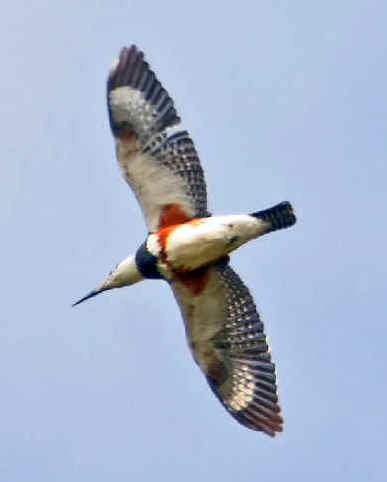
Above & below: the female Belted Kingfisher
Above, in flight. Below, perched.
(photos by Howard Eskin)
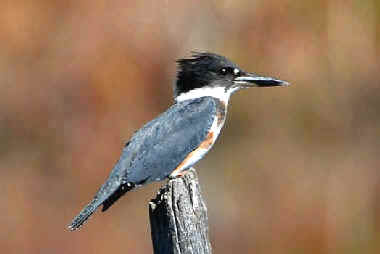
And below, another photo of a Belted
Kingfisher. (photo by Ed
Kendell)
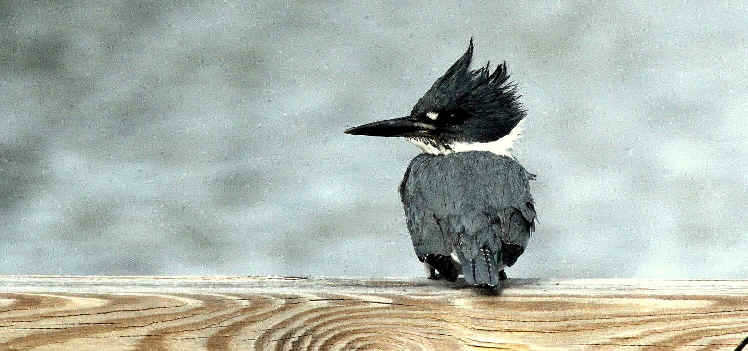
- Green Kingfisher (*) (ph) ______
AZ:jul
TX:may
Chloroceryle americana septentrionalis
South of the US, the Green Kingfisher has been seen
during FONT tours in Argentina, Belize, Brazil, Costa Rica, Ecuador, Guatemala, Honduras,
Mexico, Venezuela.
- Amazon Kingfisher ______ (r/US)
Chloroceryle amazona
The Amazon Kingfisher is a species of South and Central America, north to Mexico. A first north of
Mexico occurred in Laredo, Texas, on January 24, 2010.
South of the US, the Amazon Kingfisher has been seen during FONT
tours in Argentina, Belize, Brazil, Costa Rica, Ecuador, Guatemala, Honduras, Panama,
Venezuela.
HOOPOE
- Eurasian Hoopoe ______ (r/US)
Upupa epops
The Eurasian Hoopoe is an Old World species, where it is widespread. There is a specimen from
Alaska, found at Old Chevak in the Yukon-Kushokwin Delta, September 2-3,
1975.
Outside North America, the Eurasian Hoopoe has been seen during FONT
tours in Bulgaria, Hungary, Japan (on Hegura Island), Poland,
Romania, Spain, Turkey.
WOODPECKERS
- Eurasian Wryneck ______ (r/US)
Jnyx torquilla
An Old World species, where it is widespread. Two North American records
are from Alaska. There was a specimen from Cape Prince of Wales on September
8, 1945, and a bird was photographed at Gambell, St. Lawrence Island,
September 2 to 5, 2003.
Outside North America, the Eurasian Wryneck has been found during
FONT tours in Bulgaria, Hungary, Poland, Romania, Slovakia, Spain.
- Lewis' Woodpecker (*) ______
CO:apr,jul
WA:sep
Melanerpes lewis
- Red-headed Woodpecker (nt) (*) (ph) ______ DE:may
NC:may,jun NE:mar
Melanerpes erthrocephalus

An adult Red-headed Woodpecker
(photo by Howard Eskin)
- Acorn Woodpecker (*) (ph) ______
AZ:jan,jul,aug,sep
CA:sep TX:apr,may
Melanerpes f. formicivorus
South of the US, the Acorn Woodpecker has been seen during
FONT tours in Belize, Costa Rica, Guatemala, Honduras, Mexico.
- Golden-fronted Woodpecker (*) (ph)
______ TX:mar,apr,may
Melanerpes a. aurifrons
South of the US, the Golden-fronted Woodpecker has
been seen during FONT tours in Belize, Guatemala, Honduras, Mexico.
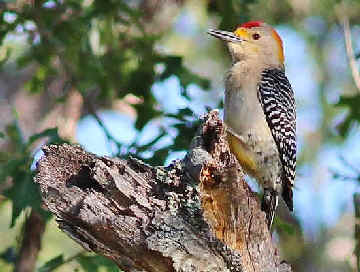
A Golden-fronted Woodpecker
photographed in Texas
(photo by Rhett Poppe)
- Red-bellied Woodpecker (*) (ph)
______ CO:apr DE:mar,apr,may FL:apr IA:mar NC:may,jun,jul,aug NE:mar TX:mar,may
Melanerpes carolinus
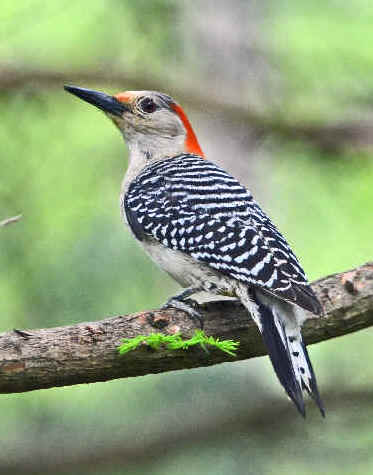
Red-bellied Woodpecker
In this photo, the tinge of red on the belly is not visible.
(photo by Howard Eskin)
- Gila Woodpecker (*) (ph) ______
AZ:jan,jul,aug,sep
Melanerpes uropygialis
- Williamson's Sapsucker (*) ______ CO:apr,jul
Sphyrapicus thyroideus
- Yellow-bellied Sapsucker (*) (ph) ______
NE:mar
Sphyrapicus varius
South of the US, the Yellow-bellied Sapsucker has been
seen during FONT tours in the Cayman Islands, Costa Rica, the
Dominican Republic, Guatemala, Mexico.
- Red-naped Sapsucker (*) (ph) ______ AZ:jan
CO:apr,jul TX:apr WA:sep WY:apr
Sphyrapicus nuchalis
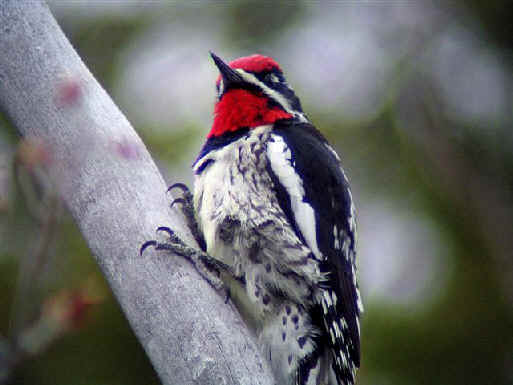
A Red-naped Sapsucker photographed during a FONT tour
- Red-breasted Sapsucker (*) ______ BC:sep
WA:sep
Sphyrapicus ruber
- Ladder-backed Woodpecker (*) (ph)
______ AZ:jan,jul,aug,sep
CO:apr
NM:apr,jul TX:mar,apr,may
Picoides scalaris
South of the US, the Ladder-backed Woodpecker has been
seen during FONT tours in Mexico.
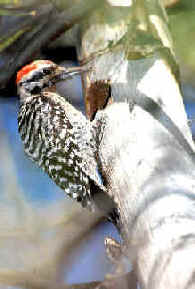
Two photos of Ladder-backed Woodpeckers
(upper photo by Howard Eskin; lower photo by Abram Fleishman)
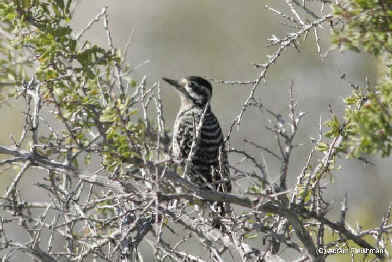
- Downy Woodpecker (*) ______ AK:may,jun
BC:sep CA:sep
CO:apr,jul DE:mar,apr,may IA:mar KS:apr NC:may,jun,aug NE:mar
TX:may WA:sep WY:apr
Picoides p. pubescens
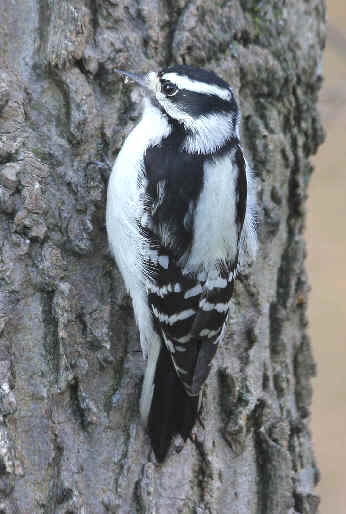
Downy Woodpecker
(photo by Doris Potter)
- Hairy Woodpecker (*) (ph) ______
AK:may,jun
AZ:jul,aug BC:sep CA:sep
CO:apr,jul DE:apr,may NC:jun NE:mar NF:jul WA:sep WY:apr
Picoides villosus
South of the US, the Hairy Woodpecker has been seen during
FONT tours in Costa Rica, Guatemala, Mexico, Panama.
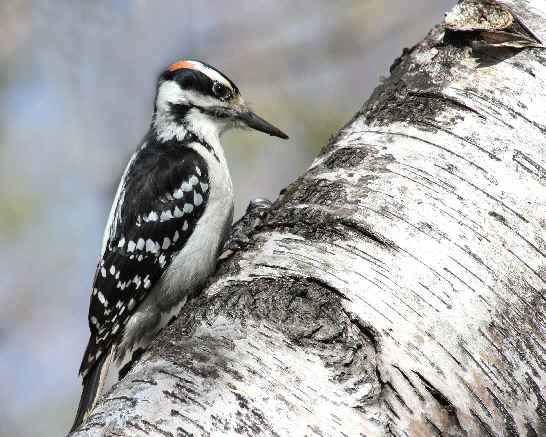
Hairy Woodpecker
(photo by Doris Potter)
- Red-cockaded Woodpecker (t3) (USe) (*) (ph)
______ NC:may,jun
Picoides borealis
- Nuttall's Woodpecker (*) ______ CA:sep
Picoides nuttallii
- White-headed Woodpecker (*) ______ CA:sep WA:sep
Picoides albolarvatus
- American Three-toed Woodpecker (*)
______ AK:may,jun WA:sep
Picoides dorsalis
Until recently, the American Three-toed Woodpecker was considered
conspecific with what is now the Eurasian Three-toed Woodpecker, Picoides
tridactylus.
Outside North America, the Eurasian Three-toed Woodpecker has
been seen during FONT tours in Poland, Romania, Slovakia.
- Black-backed Woodpecker (*) ______
AK;may,jun NF:jul
Picoides arcticus
- Arizona Woodpecker (*) ______
AZ:jul,aug,sep
Picoides arizonae
What is now in Arizona the Arizona Woodpecker was called the Strickland's
Woodpecker, but the Arizona has been split from it, and the Strickland's
Woodpecker is now in Mexico.
- Northern Flicker (*) ______
AK:jun
AZ:jan,jul,aug,sep BC:sep CA:sep
CO:apr,jul DE:apr,may IA:mar KS:apr MD:apr NC:may,jun,jul,aug NE:mar,apr
NF:jul TX:apr WA:sep WY:apr
Colaptes auratus collaris "Red-shafted Flicker"
(*) ______ AK:jun AZ:jan,jul,aug,sep BC:sep CA:sep CO:apr,jul
KS:apr
TX:apr WA:sep
Colaptes a. auratus "Yellow-shafted Flicker"
(*) ______ CO:apr,jul DE:apr,may IA:mar
MD:apr NC:may,jun,jul,aug NE:mar,apr NF:jul
WY:apr
South of the US, the "Yellow-shafted" Northern
Flicker has been seen during FONT tours in the Cayman Islands (an
endemic subspecies, C. a. gundlachi ).
South of the US, the "Red-shafted" Northern Flicker
has been seen during FONT tours in Guatemala, Honduras, Mexico.
- Gilded Flicker (*) (ph) ______
AZ:jul,sep
Colaptes chrysoides
South of the US, the Gilded Flicker has been seen during FONT
tours in Mexico (Sonora).
- Pileated Woodpecker (*) (ph) ______
CA:sep
DE:may FL:apr MD:apr NC:may,jun,aug WA:sep
Dryocopus pileatus

Pileated Woodpecker
- Ivory-billed Woodpecker ______ (apparently now extinct)
Campephilus principalis
The American Birding Association (ABA) has determined that
reports of the Ivory-billed Woodpeckers in the US in the early 21st
Century were not supported by any verifiable evidence (such as photographs,
audio recordings, and specimens).
The last verifiable evidence for the occurrence of the Ivory-billed
Woodpecker in North America is from James Tanner's research in the late
1930s. Many specimens and a few photographs and audio recordings predate
Tanner's work.
Recent DNA evidence (published in 2006) indicates that what has been
said to be a subspecies of the Ivory-billed Woodpecker in
Cuba, Campephilus principalis bairdii, is (was) not.
First described in 1863 as a separate species, the Cuban bird has been shown
to be a species more closely related to the Imperial Woodpecker of
Mexico than to the Ivory-billed Woodpecker of the southeastern United
States.
By that year (2006), it may well have been that all 3 of these woodpeckers
had become extinct.
- Great Spotted Woodpecker (ph) ______
(r/US)
Dendrocopos major
The Great Spotted Woodpecker is a widespread Eurasian species. Has occurred rarely in Alaska in the
western Aleutian Islands & the Pribilof Islands, and more rarely on the
mainland, including a bird north of Anchorage.
Outside North America, the Great Spotted Woodpecker has been seen
during FONT tours in Bulgaria, the Canary Islands, Hungary, Japan,
Poland, Romania, Slovakia, Spain, Sweden, Turkey.
TITYRA & BECARDS
- Masked Tityra ______ (r/US)
Tityra semifasciata
The Masked Tityra is a Neotropical species, ranging from northwestern & northeastern Mexico
south to Brazil. One was in south Texas at the Bentson-Rio Grande Valley
State Park, from February 17 to March 10, 1990.
South of the US, the Masked Tityra has been seen during FONT
tours in Belize, Brazil, Costa Rica, Ecuador, Guatemala, Honduras, Mexico, Panama,
Venezuela.
- Rose-throated Becard (*) ______
(r/US) AZ:jul (r/AZ)
Pachyramphus aglaiae
The Rose-throated Becard is a species of mostly Mexico & Central America. It has occurred rarely
& locally in southeastern Arizona, and more rarely along the Rio Grande
Valley of Texas, where it has bred. Occurrences in Texas have been mostly in
the winter.
South of the US, the Rose-throated Becard has been seen during
FONT tours in Belize, Costa Rica, Guatemala, Honduras,
Mexico.
- Gray-collared Becard ______
(r/US)
Pachyramphus major
The Gray-collared Becard is a species of Mexico and northern Central America. One occurred in the
Chiricahua Mountains of southeastern Arizona on June 5, 2009. There was
another (or the same) at another Chiricahua location on June 19, 2009.
South of the US, the Gray-collared Becard has been seen during FONT
tours in Belize, Guatemala, Mexico.
FLYCATCHERS
- Greenish Elaenia ______ (r/US)
Myiopagis viridicata
The Greenish Elaenia is a Neotropical species, occurring from southern Durango & southern
Tamaulipas in Mexico south to northern Argentina. In North America, there is
a record from the upper gulf coast of Texas at High Island from May 20 to
23, 1984.
South of the US, the Greenish Elaenia has been seen during
FONT tours in Brazil, Costa Rica, Guatemala, Honduras, Mexico.
- White-crested Elaenia ______ (r/US)
Elaenia albiceps chilensis
The White-crested Elaenia is a South American species. One was found along the Texas coast, at South
Padre Island, on February 9, 2008. The bird, that called continuously, was
determined to be the subspecies chilensis, an austral migrant that
breeds in southern South America. To get to Texas, that long-distance
traveler overshot even further.
A bird that was thought to be a Caribbean Elaenia, Elaenia
martinica, was seen and photographed in Escambia County, Florida in
April 1984. It may or may not have been. While the bird was certainly an elaenia,
its identity as to a species could not be determined. The consideration came
down to 2 species, either a White-crested or a Carbbean Elaenia.
South of the US, the White-crested Elaenia has been seen during
FONT tours in Argentina, Brazil, Chile (2 races), Ecuador.
South of the US, the Caribbean Elaenia has been seen during FONT
tours in Barbados, the Cayman Islands, Dominica, Mexico (Cozumel
Island), Puerto Rico, Saint Lucia, Saint Vincent.
- Northern Beardless Tyrannulet (*)
______ AZ:jul
Camptostoma imberbe
South of the US, the Northern Beardless Tyrannulet has
been seen during FONT tours in Costa Rica, Guatemala, Mexico.
- Olive-sided Flycatcher (nt) (*)
______ AK:jun
AZ:aug CA:sep CO:jul TX:may WA:sep
Contopus cooperi (previously Contopus borealis)
South of the US, the Olive-sided Flycatcher has been seen during
FONT tours Brazil (Amazonian; where rare), Costa Rica,
Ecuador, Guatemala, Mexico, Panama.
An alternate name for Contopus cooperi could
be Boreal Pewee, maybe more apt when the bird was Contopus
borealis.
- Greater Pewee (*) ______ AZ:jul,aug,sep
Contopus pertinax
South of the US, the Greater Pewee has been seen during FONT
tours in Guatemala, Honduras, Mexico.
- Western Wood Pewee (*) ______
AK:may,jun
AZ:jul,aug,sep CA:sep CO:jul TX:apr WA:sep
Contopus sordidulus
South of the US, the Western Wood Pewee has been seen
during FONT tours in Costa Rica, Guatemala, Honduras, Mexico, Panama.
- Eastern Wood Pewee (*) (ph) ______
DE:may
FL:apr
(DT) NC:may,jun,aug TX:apr,may
Contopus virens
South of the US, the Eastern Wood Pewee has been found
during tours in the Brazil (Amazonian), Cayman Islands (during migration),
Ecuador, Guatemala, Panama.
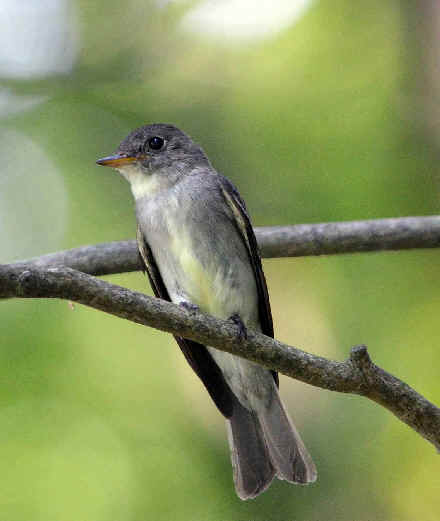
Eastern Wood Pewee
(photo by Howard Eskin)
- Cuban Pewee ______ (r/US)
Conotopus caribaeus
The Cuban Pewee is a West Indian species that is a resident of the
northern Bahamas and Cuba. It has occurred in Florida at least 3 times,
probably more. The most recent occurrence was at Long Pine Key in the
Everglades National Park, September 5-27, 2010.
Two other documented occurrences were both in Boca Raton, in the early
spring of 1995 and in the fall of 1999. Other possible occurrences, not well
documented, were in Key Large in 2001,and "many years ago" at the
Dry Tortugas.
- Yellow-bellied Flycatcher (*) ______ NF:jul
Empidonax flaviventris
South of the US, the Yellow-bellied Flycatcher has been
seen during FONT tours in Belize, Costa Rica, Guatemala, Honduras,
Mexico, Panama.
- Acadian Flycatcher (*) ______
DE:may
NC:may,jun
TX:may
Empidonax virescens
South of the US, the Acadian Flycatcher has been seen
during FONT tours in Guatemala, Honduras, Panama.
- Alder Flycatcher (*) ______
AK:jun
TX:may
Empidonax alnorum
South of the US, the Alder Flycatcher has been seen during
FONT tours in Guatemala.
- Willow Flycatcher (*) ______
AZ:aug
CA:sep CO:jul DE:may TX:may WA:sep
Empidonax trailii
South of the US, the Willow Flycatcher has been seen
during FONT tours in Costa Rica, Guatemala, Mexico, Panama.
- Least Flycatcher (*) ______
CA:sep
(r/CA)
Empidonax minimus
In California, seen at Point Reyes during the FONT West Coast
Tour in September 1991.
South of the US, the Least Flycatcher has been seen during FONT
tours in Belize, Guatemala, Honduras, Mexico.
- Hammond's Flycatcher (*) ______
AK:jun
AZ:sep
Empidonax hammondii
South of the US, the Hammond's Flycatcher has been seen
during FONT tours in Guatemala.
- Gray Flycatcher (*) ______
AK:aug
CO:apr TX:apr WA:sep
Empidonax wrightii
South of the US, the Gray Flycatcher has been seen
during FONT tours in Mexico.
- Dusky Flycatcher (*) (ph) ______
AZ:aug
CO:jul KS:apr
(r/KS) WA:sep
Empidonax obehholseri
South of the US, the Dusky Flycatcher has been seen during FONT tours
in Mexico.
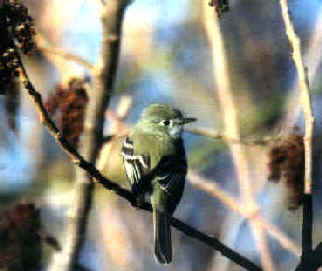
Dusky Flycatcher
(photo by Marie Gardner)
- Cordilleran Flycatcher (*) ______
AZ:jul,aug,sep
CO:jul NM:apr TX:apr,may WA:sep
Empidonax occidentalis
South of the US, the Cordilleran Flycatcher has been seen
during FONT tours in Mexico.
The Cordilleran Flycatcher and the more-westerly Pacific-slope
Flycatcher (below) were previously combined as the "Western
Flycatcher", Empidonax difficilis.
- Pacific-slope Flycatcher (*) ______ CA:sep
Empidonax difficilis
As noted above, the scientific name of the Pacific-slope Flycatcher
was that of the former "Western Flycatcher".
- Buff-breasted Flycatcher (*) ______
AZ:jul,aug
Empidonax fulvifrons
South of the US, the Buff-breasted Flycatcher has been seen
during FONT tours in Guatemala, Mexico.
- Northern Tufted Flycatcher ______
(r/US)
Mitrephanes phaeocercus
A Neotropical species ranging from Mexico to northern South America. In
the northern part of its range (northern Mexico), it is migratory. In the
US, it has rarely occurred, in the winter and early spring, in west Texas
and in western Arizona.
South of the US, the Northern Tufted Flycatcher has been seen during
FONT tours in Costa Rica, Guatemala, Honduras, Mexico, Panama.
- Black Phoebe (*) ______ AZ:jan,jul,aug,sep
CA:sep
NM:apr TX:apr,may
Sayornis nigricans
South of the US, the Black Phoebe has been seen during
FONT tours in Argentina, Belize, Costa Rica, Ecuador, Guatemala, Honduras, Mexico, Panama,
Venezuela.
- Eastern Phoebe (*) ______
CO:apr DE:apr,may IA:mar KS:apr NC:jun NE:mar OK:apr
TX:mar,may
Sayornis phoebe
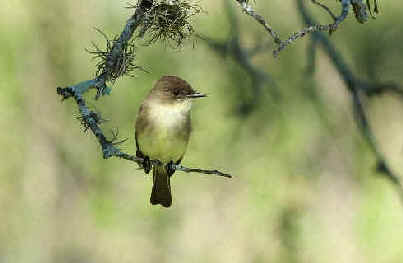
An Eastern Phoebe photographed in Texas
(photo by Rhett Poppe)
- Say's Phoebe (*) (ph) ______
AK:may
AZ:jan,jul,aug,sep CA:sep
CO:apr,jul
KS:apr NE:mar NM:apr TX:apr,may WA:sep
Sayornis saya
South of the US, the Say's Phoebe has been seen during
FONT tours in Mexico.
- Vermilion Flycatcher (*) (ph) ______
AZ:jul,aug,sep
CO:apr
(r/CO) NM:apr TX:mar,apr,may
Pyrocephalus rubinus
South of the US, the Vermilion Flycatcher has been seen
during FONT tours in Argentina, Belize, Bolivia, Brazil, Chile (far-north),
Chile, Guatemala,
Mexico, Paraguay, Venezuela.
What was part of the Vermilion Flycatcher on the Galapagos
Islands, Ecuador is now the Darwin's Flycatcher, Pyrocephalus
nanus.
It has been seen during FONT tours there.
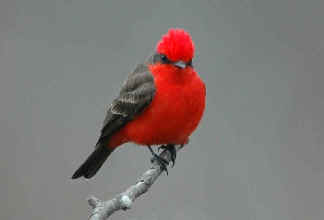
Vermilion Flycatchers; male above, female below
(upper photo by Howard Eskin; lower
photo by Marie Gardner)

- Ash-throated Flycatcher (*) (ph)
______ AZ:jul,aug,sep
CA:sep
CO:apr
NM:apr TX:apr,may
Myiarchus cinerascens
South of the US, the Ash-throated Flycatcher has been seen
during FONT tours in Guatemala, Mexico.
- Great Crested Flycatcher (*) (ph)
______ DE:may MD:may
NC:may,jun,aug
TX:apr
Myiarchus crinitus
South of the US, the Great Crested Flycatcher has been
seen during FONT tours in Belize, Costa Rica, Guatemala, Honduras,
Mexico, Panama, Puerto Rico (where rare).
- Brown-crested Flycatcher (*) ______
AZ:jul,aug
TX:apr,may (a former name was Wied's Crested Flycatcher)
Myiarchus tyrannulus
South of the US, the Brown-crested Flycatcher has been
seen during FONT tours in Argentina, Belize, Bolivia, Brazil, Costa Rica, Guatemala, Honduras,
Mexico, Venezuela.
- Dusky-capped Flycatcher (*) (ph)
______ AZ:jul,aug
Myiarchus tuberculifer
South of the US, the Dusky-capped Flycatcher has been seen during
FONT tours in Argentina, Belize, Brazil, Costa Rica, Ecuador, Guatemala, Honduras, Mexico,
Panama, Venezuela.
- Nutting's Flycatcher (ph) ______ (r/US)
Myiarchus nuttingi
The Nutting's Flycatcher ranges from northwest Mexico to Costa Rica. There are very
few winter records in the US, in southeast Arizona and in coastal southern
California.
The Nutting's Flycatcher is difficult to tell from the Ash-throated
Flycatcher, a common species of the southwest US. The mouth-lining of the
Nutting's Flycatcher is orange, not flesh-colored.
South of the US, the Nutting's Flycatcher has been seen during
FONT tours in Costa Rica, Guatemala, Mexico.
- La Sagra's Flycatcher ______ (r/US)
Myiarchus sagrae
The La Sagra's Flycatcher is a West Indian species, in the Bahamas, Cuba, and the Cayman Islands. It
was, at one time, conspecific with the Stolid Flycatcher also in the
West Indies.
The La Sagra's Flycatcher has rarely occurred in south Florida,
mainly in the winter and spring, and more rarely in Alabama.
South of the US, the La Sagra's Flycatcher has been seen during
FONT tours in the Cayman Islands.
The closely-related Stolid Flycatcher has been seen during FONT
tours in the Dominican Republic, Jamaica.
- Great Kiskadee (*) (ph) ______ TX:mar,may
Pilangus sulphuratus
South of the US, the Great Kiskadee has been seen during
FONT tours in Argentina, Belize, Bolivia, Brazil, Costa Rica, Ecuador, Guatemala, Honduras, Mexico,
Panama, Paraguay, Uruguay, Venezuela.
- Social Flycatcher (ph) ______
(r/NA)
Myiozetetes similis
The Social Flycatcher is a common Neotropical species from northeastern & northwestern Mexico
south to northeast Argentina. There is a documented record from the Bentson-Rio
Grande Valley State Park, in south Texas, from January 7 to 14, 2005.
South of the US, the Social Flycatcher has been seen during FONT
tours in Argentina, Belize, Bolivia, Brazil, Costa Rica, Ecuador, Guatemala, Honduras, Mexico,
Panama, Paraguay, Venezuela.
- Sulphur-bellied Flycatcher (*) ______
AZ:jul,aug
Myiodynastes luteiventris
The Sulphur-bellied Flycatcher occurs rather commonly in southeastern Arizona in the
summer, where it breeds. Otherwise in the US, it has been found rarely along
the Gulf Coast and in coastal California.
South of the US, the Sulphur-bellied Flycatcher has been seen
during FONT tours in Costa Rica, Guatemala, Honduras, Mexico, Panama.
- Piratic Flycatcher ______ (r/US)
Legatus leucophalus
The Piratic Flycatcher is a Neotropical species, widespread and migratory. In the US, there have
been occurrences at the Dry Tortugas in Florida (in March 1991), on an oil rig in the Gulf
of Mexico (in Texas), at Big Bend National Park in Texas, and in eastern New
Mexico.
South of the US, the Piratic Flycatcher has been seen during FONT
tours in Argentina, Belize, Brazil, Costa Rica, Ecuador, Guatemala, Honduras, Mexico, Panama,
Venezuela.
- Variegated Flycatcher ______ (r/NA)
Empidonomus varius
The Variegated Flycatcher is a Neotropical species. It has occurred very rarely in eastern North
America.
South of the US, the Variegated Flycatcher has been seen during FONT
tours in Argentina, Brazil, Ecuador, Venezuela.
- Crowned Slaty Flycatcher ______
(r/US)
Griseotyrannus aurantyoatocristatus
The Crowned Slaty Flycatcher is a species of South America, where it is an austral migrant. One was
found in Louisiana on June 3, 2008, in Cameron Parish, about 25 miles east
of the Texas border. It was collected.
South of the US, the Crowned Slaty Flycatcher has been seen
during FONT tours in Argentina, Brazil, Ecuador.
- Tropical Kingbird (*) (ph) ______
(r/US) AZ:jul,aug,sep
TX:may
Tyrannus melancholicus
South of the US, the Tropical Kingbird has been seen
during FONT tours in Argentina, Belize, Bolivia, Brazil, Costa Rica,
Ecuador, Guatemala, Honduras, Mexico,
Panama, Paraguay, Uruguay, Venezuela.
- Couch's Kingbird (*) (ph) ______
TX:may
Tyrannus couchii
A Couch's Kingbird on Manhattan in New York City in late
December 2014 and into January 2015 was a first state record. The bird was found on Christmas Day.
Another Couch's Kingbird was in Maryland in November, the first for
that state.
Very similar to the Tropical Kingbird, the Couch's Kingbird in
New York was identified by its call.
The neighborhood where the Couch's Kingbird opted to call home, for
at least a while, was Abingdon Square in the West
Village.
South of the US, the Couch's Kingbird has been seen in Belize,
Mexico.
- Cassin's Kingbird (*) ______
AZ:jul,aug
CO:apr NM:aug TX:apr
Tyrannus v. vociferans
South of the US, the Cassin's Kingbird has been seen
during FONT tours in Guatemala, Mexico.
At the same time as the Couch's Kingbird (above) in
December 2014 and January 2015, there was also a Cassin's Kingbird
in New York City. The Cassin's Kingbird was in Brooklyn at Floyd
Bennett Field.
- Western Kingbird (*) (ph) ______
AZ:jul,aug,sep
CA:sep
CO:apr,jul
KS:apr NM:apr,jul,aug TX:apr,may
Tyrannus verticalis
South of the US, the Western Kingbird has been seen during
FONT tours in Guatemala, Mexico.
- Eastern Kingbird (*) (ph) ______
CA:sep
CO:jul DE:may FL:apr (DT) MD:apr,may NC:may,jun,jul,aug TX:apr,may
Tyrannus tyrannus
In California, seen at Point Reyes in 1991 & 2005, both times
during the FONT West Coast Tour in September.
South of the US, the Eastern Kingbird has been seen during FONT
tours in Costa Rica, Ecuador, Guatemala, Honduras, Mexico, Panama.
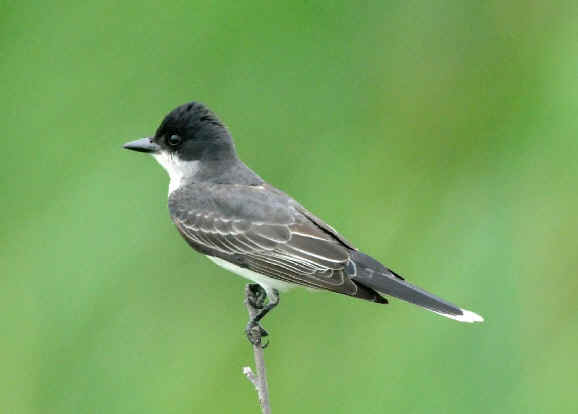
Eastern Kingbird
(photo by Howard Eskin)
- Gray Kingbird (*) (ph) ______
FL:apr (DT)
Tyrannus dominicensis
South of the US, the Gray Kingbird has been seen during FONT
tours in Barbados, the Cayman Islands, Dominica, the
Dominican Republic, Haiti, Honduras (Caribbean coast), Jamaica,
Panama, Puerto Rico, Saint Lucia, Saint Vincent, Venezuela.
- Loggerhead Kingbird (ph) ______ (r/US)
Tyrannus caudifasciatus
A West Indian species. There have been 3 recent occurrences (considered
credible) in far-southern Florida. Two have been in Key West, on March 8,
2007 & April 12, 2009. Another was on the Dry Tortugas on March 14,
2008.
South of the US, the Loggerhead Kingbird has been seen during FONT
tours in the Cayman Islands, the Dominican Republic,
Jamaica, Puerto Rico.
- Thick-billed Kingbird (*) ______
AZ:jul,aug
Tyrannus crassirostris
South of the US, the Thick-billed Kingbird has been seen during
FONT tours in Mexico.
- Scissor-tailed Flycatcher (*) (ph) ______
AZ:aug (r/AZ) NM:apr (r/NM) TX:apr,may
Tyrannus forficalus
South of the US, the Scissor-tailed Flycatcher has
been seen during FONT tours in Costa Rica, Guatemala, Mexico, Panama.
-
Fork-tailed Flycatcher (ph) ______ (r/NA)
Tyrannus savana
The Fork-tailed Flycatcher is a widespread Neotropical species, with the
southernmost breeding race in South America being a long-distance austral
migrant. The bird has occurred as a rarity many places in North America,
with occurrences every year. In eastern North America, there have been
records in the spring & fall, with most being in the fall. The few
records in western North America have been in the fall. There are several
winter records from the southwest
US.
South of the US, the Fork-tailed Flycatcher has been seen
during FONT tours Argentina, Belize, Bolivia, Brazil, Costa Rica,
Ecuador, Guatemala, Honduras,
Panama, Paraguay, Venezuela.
To
Top of Page.


 The
Birds
of
The
Birds
of 























































